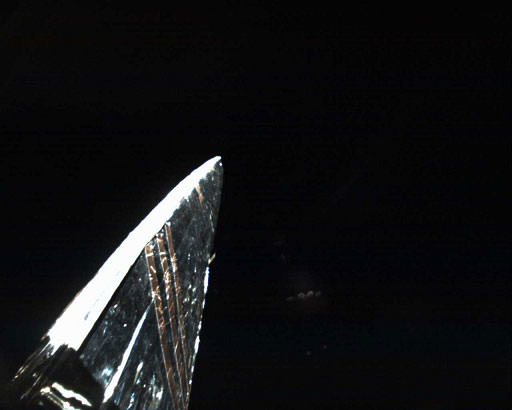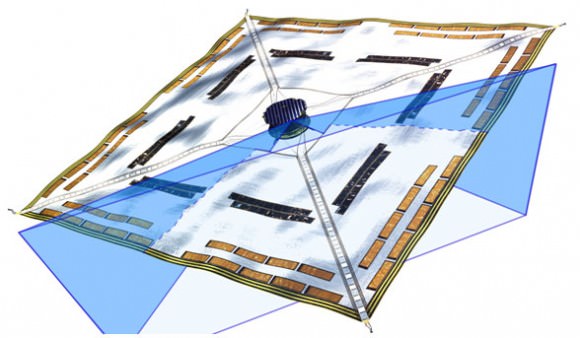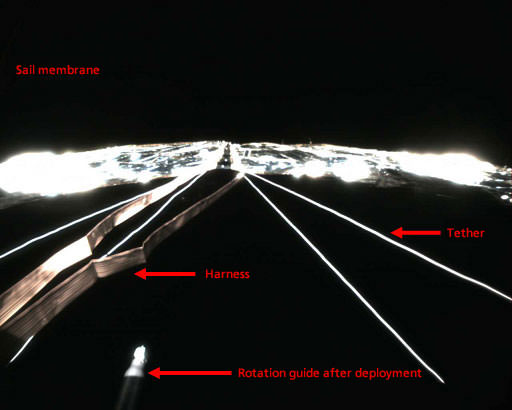[/caption]
New images and data from the IKAROS solar sail show the thin solar film has deployed and expanded successfully and is now generating power. Since its launch on May 21, 2010, teams from the Japan Aerospace Exploration Agency (JAXA), have been painstakingly checking out all the systems on IKAROS before deploying the sail, and even the process of unfurling the sail had been a slow process. JAXA began to deploy the sail on June 3, analyzing each step before proceeding. Yesterday, JAXA released a photo of a partially deployed sail (below), but didn’t offer much information as far as the status. But they now have confirmed that the sail was successfully expanded and is generating power. IKAROS is now about 7.7 million km from Earth.
In the image above, the harness is an electrical connection between the membrane and the main body, and the tether is the mechanical connection between the membrane and the main body.
And now comes the big test of the solar sail: will it provide the ability to navigate the spacecraft?
“We will measure and observe the power generation status of the thin film solar cells, accelerate the satellite by photon pressure, and verify the orbit control through that acceleration,” JAXA said in a press release. “Through these activities, we will ultimately aim at acquiring navigation technology through the solar sail.”
The craft will head towards Venus, and the exciting part will be finding out how fast and accurate the solar sail can fly.

From the IKAROS blog (translated from Japanese):
First, the spin rate and learned that he had first IKAROS have successfully deployed from the attitude data. Then, I was part of the downlink data captured with the camera image monitor confirmed that the sail has been deployed from the image. On June 10 has been expanded to clean the sail, “stretched states” get the picture, confirmed the successful deployment of the sail after deployment finished the second check.
Also check the power of solar cells was carried out together, we achieved minimum success!
Power will be realized with the world’s first solar powered sail development.

See the IKAROS webpage for more info and detailed graphics.
Sources: JAXA, IKAROS blog


You said: “IKAROS is now about 770 million km from Earth.” Wow. 3 weeks and it’s already almost further than Jupiter? Wow. Let me repeat that: wow. It’s got to be the fastest spacecraft ever!
ioresult — that was a typo, which has now been fixed. It is 7.7 million km away from Earth. Sorry about that.
It’s 7,7 million kilometers. Now that the solar panels are deployed can we oberve it? I send a message to JAXA for that matter.
No, it’s got to be the _coolest_ spacecraft ever!
To quote myself from elsewhere:
Do they have any idea of the potential speed of this solar sail? Either way I cant wait to find out the speed of this new technology.
And they paid a good price, because….ahem, they got it on sail! hehehe
@deuceof9
If you have the time to accelerate, almost light-speed.
It is interesting sail concept indeed; centrifugal force to deploy the sail and hang the central spacecraft with tethers, and steer the craft with variable reflectance at the outer edge. Well, the deployment system worked. I hope the steering system works and spacecraft stays stable.
Kudos to the mission team. Here are a couple videos for those who are interested in Solar Sails. The first is about simulated solar-sail trajectories and their potential speeds, and the second is a JAXA promotional video for IKAROS (Japanese only).
http://www.youtube.com/watch?v=Wfa1ggUlKnk
Fully deployed
JAXA will have it
made in the shade!
It’s a bit funny that they go for Venus. That way they will be sailing against the “wind” which complicates maneuvering. I guess that was the only train going so they had to take that route. At any rate, it’s a wonderful achievement and as far as I can remember it’s a first. Congratulations JAXA and Japan.
Regards,
/hydrazine
hydrazine, it is actually not that weird, going to Venus or to the outer planets. The craft is orbiting at the same speed of Earth in the same direction once launched in reference to the Sun. So going towards the sun or further away is basically speeding up or slowing down in the orbit direction. (pro-grade/retro-grade)
It is basically pointing the craft towards the orbit direction and speed up, or point it against orbit the direction and thus slow down.
It is not moving in a straight line from Earth to Sun or straight away from the sun. The Sun is not blowing away the space craft, it just gives additional energy the space craft can use.
To add to the confusion solar sail uses only the photon energy, not the solar wind and not the magnetic fields of the sun.
you know what would be really cool? go to Venus, then Mercury or Mars. Just any planet you want, because you have almost non-existing fuel budget! Maybe try an asteroid…or slingshot around the sun…just to see how fast it can go